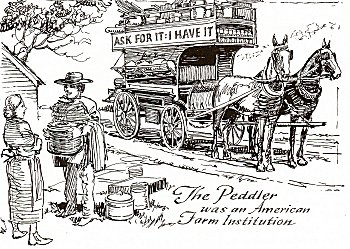![]()

Another vanished knight of the road is the old-fashioned peddler whose home and shop was his wagon. He both bought and sold as he went, often selling his stock, wagon and all. Starting anew, with a few wares on his back, he invariable returned with a new horse and wagon and a tidy profit besides.
"Peddler" and "drummer" are typically American words. The ancient Scotch "peder" or foot-salesman became the "pedlar" of the New World. Although in England "peddlers" traveled only by foot and "hawkers" went only by wagon, anone who sold wares from door to door in America became commonly known of peddlers.
The drummer, or man who went about "drumming up trade," actually stemmed from the earliest time when drums were used to attract public attention, just as when church was called a drum, and public announcements were made after a drum call. The first American peddlers often carried a drum known as a"chapman's" drum."
The Yankee peddler was known to the townspeople of his time as a "chapman," a word which comes from the Anglo-Saxon "ceap" for trade, plus "man:" hence a "cheap-man." The chapman who later won fame as a Yankee peddler often carried a drum and an America flag and boasted loudly that he sold only American goods. Actually, it was illegal for him to do otherwise, but he was a good salesman.
The Yankee peddler was the original American who could "sell anyone anything." One of his claims to fame is the origination of the name "Nutmeg State" for Connecticut, this derived from the belief that the Connecticut peddler sold wooden nutmeg as real ones. Few people, however, know that nutmegs were famous in Connecticut on their own merits. The nutmeg was the most popular flavoring of the old days; it was even favored as a gift.
Nutmegs were gilded and ribboned and given as presents, not only because of their worth, but because they were supposed to have great medicinal value. Some of the silver trinkets of colonial days which many people believed were snuff boxes were actually nutmet-holders. The inside of the cover was often pierced to form a grater and served also as an opening to let the aroma escape. The bon vivants and fashionable dames of the period carried nutmegs with them as a sign of luxury. Because nutmegs were valuable and because they were easy to carry, it was always a convenient money-maker for the traveling peddler, who was often call a "nutmeg man."
Excerpted by Maury Tosi
From Eric Sloane's booklet American Yesterday (1956)